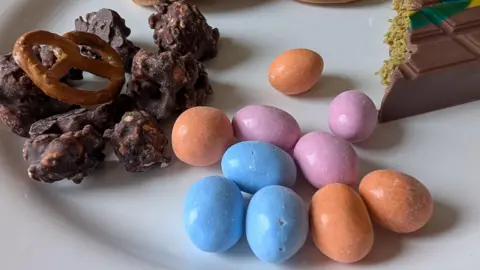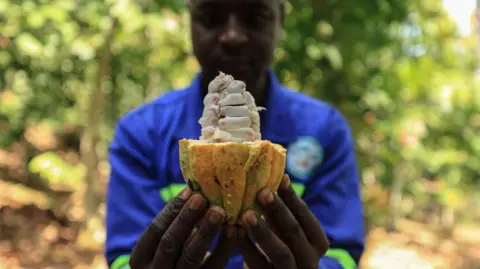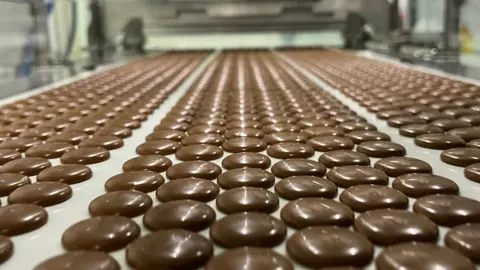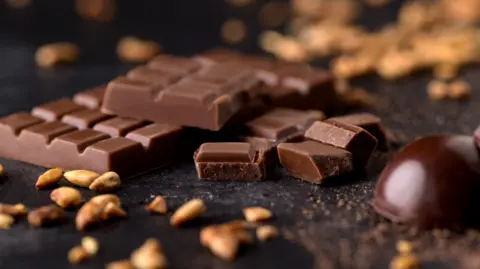Do we need cocoa-free chocolate and is it nice?
 Chris Baraniuk
Chris BaraniukThe first thing I notice is the lack of a strong aroma. There's no familiar, powerful waft of cocoa when opening this bag of sweets, the packet of biscuits, or the caramel-filled truffles.
And as I taste each one as part of my solemn commitment to inform the public, I don't get quite the same burst of chocolate flavour that you might expect from treats with that familiar, waxy, light brown chocolate-like coating. The thing is, this isn't chocolate. It's made with sunflower seeds. Or fava (also called broad) beans.
The selection before me is just a smattering of the non-cocoa containing alternatives to chocolate that are creeping into the European retail market right now. Their makers have spied an opportunity, partly because real chocolate prices are soaring.
"The average increase in price for chocolate was 9% over 2024," says Richard Caines, principal analyst in UK food and drink research at market research firm Mintel. "In January just gone, it's shot up by 14%."
That's the retail price of chocolate. The wholesale price of the key ingredient, cocoa – which is made from fermented, roasted and ground cacao beans – has increased by an astonishing 300% in 2024.
"I have been looking at this chocolate market for quite a few years now – I don't remember a big story like this on costs going up," adds Mr Caines.
A key reason for this increase is climate change-related weather impacts on cacao farms, particularly in West Africa.
Plus, some farmers in Ghana are turning away from cacao production in favour of illegal gold-mining, according to reports.
It means that there was a deficit of roughly 500,000 tonnes of cocoa in the global market last year.
 Getty Images
Getty ImagesReal chocolate could become a "luxury" item in the future says Massimo Sabatini, co-founder and chief executive of Italian firm Foreverland, which makes a cocoa powder alternative called Choruba.
The company opened its production facility in March, where staff process not cacao beans but carob husks.
Carob trees produce small, brown, banana-shaped pods containing seeds. It's possible to process the pods to create a cocoa-like powder. This chocolate alternative has a long history, however – and not a very happy one.
A New Yorker article claims a generation was "traumatized" by carob-based confectionary during the 1970s. It didn't taste as good as real chocolate, and it didn't melt in your mouth in the same way, apparently.
But Mr Sabatini insists that he and his colleagues have come up with a worthy product. He acknowledges that carob "really doesn't taste like chocolate" but adds that Foreverland's fermentation and roasting process removes some of the carob flavour to get it closer to cocoa.
Their carob-based dark chocolate alternative is sweeter and more caramel-like than real dark chocolate, he explains.
There could be health benefits to this. "We can reduce drastically the sugar content," says Mr Sabatini. Carob is also higher in fibre and lower in fat than cocoa.
 Foreverland
ForeverlandGerman food manufacturer Planet A Foods has developed a different chocolate alternative. Sara Marquart, co-founder and chief technology officer, says her goal is not to replace chocolate but to help fill the gap in the market caused by volatility in cocoa availability and prices.
Unlike Foreverland, Planet A Foods have chosen sunflower seeds as the key ingredient in their cocoa powder alternative, ChoViva.
"We process sunflower seeds like cocoa beans," explains Dr Marquart. "It's a highly abundant ingredient, there's millions and millions of tonnes on the market."
ChoViva is now present in roughly 35 different retail products, mostly on the market in Germany and France – though it also appears in mini egg-shaped sweets sold by Aldi in the UK. The sweets are made with peanuts and have a chocolate-like coating containing ChoViva.
When I try them, the flavour is overwhelmingly dominated by the salty peanut at the egg's core. But the chocolatey texture of the coating is impressive. The same applies to ChoViva-covered biscuits made by the firm.
I note that the chocolate-like coating is rather thin and not overly flavourful. But again, the texture is pretty much what you'd expect from real chocolate, though not quite as melty.
The company's ChoViva-covered popcorn is probably the most chocolatey item I try – the popcorn doesn't usurp its coating.
Overall, there's nothing here that would perturb a consumer. Especially one unaware that these products don't actually contain chocolate.
 Daniel Schvarcz
Daniel SchvarczA UK start-up also keen to compete in this space is Nukoko. Two of its founders previously ran a real chocolate business and teamed up with a food scientist to form their new venture.
"We saw first-hand the issues with the chocolate supply chain," says Ross Newton, co-founder. Like Foreverland and Planet A Foods, Nukoko has opted for a key ingredient that the firm can source and process locally – to reduce food miles and insulate against supply chain risks. But in Nukoko's case the raw material of choice is not carob or sunflower seeds but fava beans.
"There's around a million tonnes harvested in the UK every year," says Mr Newton.
It's early days for the company but he adds that he hopes to begin selling their cocoa powder alternative to food firms later this year.
Mr Newton says imitating the flavour of real chocolate is very hard but that, out of 25 crucial flavour compounds in real chocolate, his company's product manages to include 24 of them – though in some cases at slightly different concentrations.
The company sends me four caramel-filled truffles to try. The caramel totally dominates and the truffles are very sweet. But the chocolate alternative is as smooth and glossy as you'd expect, and very satisfying to chew.
"Anything new that comes out has got to meet equal taste expectations," says Mr Caines, noting how discerning consumers are when it comes to their favourite chocolate-containing products. Getting them to embrace alternatives devoid of cocoa will be no mean feat.
He adds that alternatives might fare best when used in bakery products – such as the chips in chocolate chip cookies: "The chocolate is not so much the star of the show there so it might actually be more acceptable."
Should chocolate alternatives meet with success, there is some risk that this could negatively impact cacao farmers, says Tonya Lander, a lecturer in biology at Oxford University.
"It's something that should be worked through with farmers or farmer collectives," she says. Cacao farmers are among the poorest agricultural workers in the world.
Nukoko, Planet A Foods and Foreverland all say they don't aim to replace chocolate, rather, the goal is to fill the gap left by cocoa production shortfalls.
Dr Lander and colleagues have studied environmental factors that influence yield from cacao trees.
Poor pollination and high temperatures negatively affect how much cacao the trees produce, the researchers report in a study published in February.
By shading cacao trees on plantations, for example, it might be possible to improve harvests and potentially reduce the volatility of cocoa supplies. Such interventions, besides switching to cocoa alternatives, could help satisfy confectionary-obsessed consumers in the coming years.
